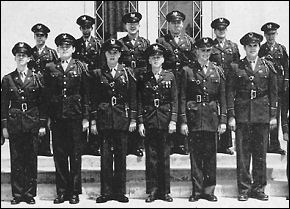
|

|

|
|
| Home | Staff | Activities | Military | Social | History | Recollections | Commentary |

|

|

|
|
| Home | Staff | Activities | Military | Social | History | Recollections | Commentary |
Military
Cheviot Hills Military Academy was a military school as the name suggests. All activities at school were structured under a military style. Uniforms had to be worn at all times. We had two uniforms, one for dress which you see in the picture of the school officers on the right and khaki for everyday use. These uniforms were purchased at Desmonds in Los Angeles. When a new student arrived at school, he stood out to the point of embarrassment because he was in civilian clothes waiting for his shipment from Desmonds which took about a month to six weeks. Cadet Officers, 1952, in the picture on the right. Notice the Sam Browne belts being worn by the officers. This was a throwback to World War I when regular military officers wore these belts. After entering the school, students or cadets as they were known would earn their way of the rank ladder similar to the standard military system. Private to PFC (one stripe) on up to master sergent with three stripes up and three down. Once a cadet was elevated to officer status, he wore insignia based upon the British System. A lieutenant at CHMA wore either a silver "pip" or a gold one rather than the bar used by the US. I suspect that the reason was to distinguish them from real military officers.
The picture on the left was Company I in 1952. And yes, the officers did carry swords on their belts. Being in the band, I carried a trombone instead.
Picture on the left is of 8th. and 9th. graders honing their marching skills. Cadet Captain Roger Burford wrote this summary of marching which appears in the 1952 yearbook: Staccato commands ring out. Dress Parade is under way. The performance of the battalion and drill company sometimes amazes a certain portion of the spectators. In reality this is just a reproduction of the daily drill which constitutes a vital part of our weekly program. However, this is not the only military discipline displayed by the cadets. At home when we gather in the dining room we reflect the manners taught us here in our mess-hall. Daily inspections show us the usefulness of keeping a tidy room. These are regular everyday activities which come naturally with experience. Monday's O'Grady Game in which every cadet has an opportunity to participate requires both concentration and skill; and at the end of the year . . . General Inspection. This is an examination by the State of California and the cadets spend days preparing for this event. But in the final analysis the very best in our training is evidenced when we leave school, for then every boy no matter where he goes reflects something he has learned at Cheviot Hills.
Notice we are wearing our regular everyday khaki uniforms in the dining room picture on the right. 
For offenders of the system, discipline was dished out measured by demerits. Each demerit earned resulted in the loss of some privileges in addition to 15 minutes of standing at rigid attention facing a wall. Four demerits earned you an hour. Once a week we had candy call. The school handed out one candy bar provided from a fund supplied by the individual parent. If you had any demerits on your record, you didn't bother showing up for candy call. The same went for swimming. A few problem kids never went swimming nor candy call. There were also other privileges that were curtailed under this system. Plus the embarrassment of having your demerits read out loud during the evening meals. |